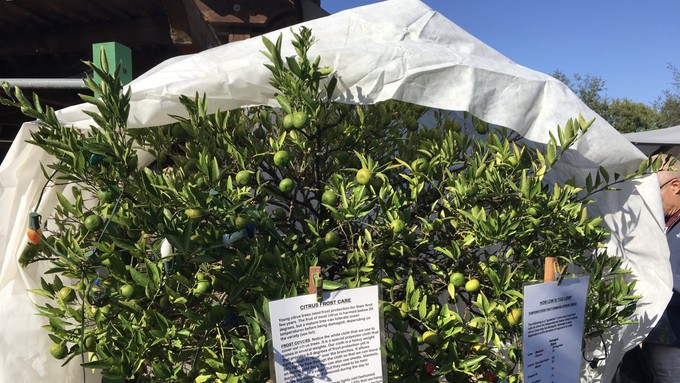
Overnight lows near freezing put poinsettias at risk

This display by the Sacramento County master gardeners shows how to protect a young citrus tree with frost cloth and/or old-fashioned Christmas lights. In practice, the cloth would be pulled completely over the tree on all sides. Kathy Morrison
According to the National Weather Service, Sacramento and its surrounding areas can expect areas of frost in the early hours of the morning Saturday through Tuesday. We’re officially under a frost warning from 11 p.m. Friday through Saturday morning.
Overnight lows are expected to dip into the low 30s every night from Friday through Tuesday.
“Near to below freezing overnight/morning temperatures will return to the Valley tonight and continue through the middle of next week,” tweeted the NWS Sacramento office on Friday morning. “Be sure to take the necessary precautions to protect pets, plants and people, especially for the vulnerable populations!”
In Sacramento, the lowest temperature currently predicted is 33 degrees in the wee hours of Tuesday morning. That’s not quite freezing, but cold enough to burn the leaves and bracts of tender poinsettias. It also can speed the decay of decorative pumpkins. To avoid damage to either, bring them indoors.
Also provide frost protection for tender new seedlings such as newly transplanted cabbage or lettuce. Slip a plastic milk jug over the whole plant; it becomes an instant mini greenhouse.
Provide protection for succulents or any remaining pepper or tomato plants. They’ll definitely feel the chill.
Bring container plants indoors or put under cover. Use cloth sheets (not plastic) for temporary protection. Make sure to remove these sheets during the day so plants don’t overheat and smother.
Except for succulents, water frost-tender plants in the late afternoon before a chilly night is predicted. That extra moisture raises the soil temperature just enough to avoid frost burn.
For more tips on freezing and frost: https://ipm.ucanr.edu/PMG/GARDEN/ENVIRON/frostdamage.html.
Comments
0 comments have been posted.Sacramento Digs Gardening to your inbox.
Food in My Back Yard Series
May 6: Maintain soil moisture with mulch for garden success
April 29: What's (already) wrong with my tomato plants?
April 22: Should you stock up on fertilizer? (Yes!)
April 15: Grow culinary herbs in containers
April 8: When to plant summer vegetables
April 1: Don't be fooled by these garden myths
March 25: Fertilizer tips: How to 'feed' your vegetables for healthy growth
March 18: Time to give vegetable seedlings some more space
March 11: Ways to win the fight against weeds
March 4: Potatoes from the garden
Feb. 25: Plant a fruit tree now -- for later
Feb. 18: How to squeeze more food into less space
Feb. 11: When to plant? Consider staggering your transplants
Feb. 4: Starting in seed starting
Sites We Like
Garden Checklist for week of May 4
Enjoy this spring weather – and get gardening!
* Plant, plant, plant! It’s prime planting season in the Sacramento area. Time to set out those tomato transplants along with peppers and eggplants. Pinch off any flowers on new transplants to make them concentrate on establishing roots instead of setting premature fruit.
* Direct-seed melons, cucumbers, summer squash, corn, radishes, pumpkins and annual herbs such as basil.
* Harvest cabbage, lettuce, peas and green onions.
* In the flower garden, direct-seed sunflowers, cosmos, salvia, zinnias, marigolds, celosia and asters. (You also can transplant seedlings for many of the same flowers.)
* Plant dahlia tubers. Other perennials to set out include verbena, coreopsis, coneflower and astilbe.
* Transplant petunias, marigolds and perennial flowers such as astilbe, columbine, coneflowers, coreopsis, dahlias, rudbeckia and verbena.
* Keep an eye out for slugs, snails, earwigs and aphids that want to dine on tender new growth.
* Feed summer bloomers with a balanced fertilizer.
* For continued bloom, cut off spent flowers on roses as well as other flowering plants.
* Add mulch to the garden to maintain moisture. Mulch also cuts down on weeds. But don’t let it mound around the stems or trunks of trees or shrubs. Leave about a 6-inch to 1-foot circle to avoid crown rot or other problems.